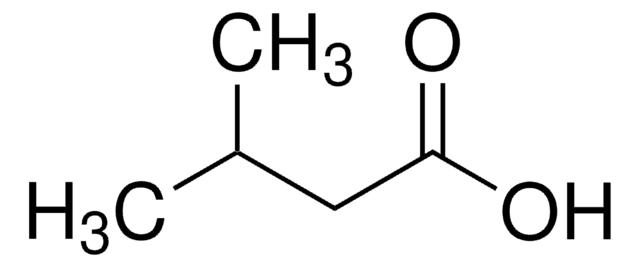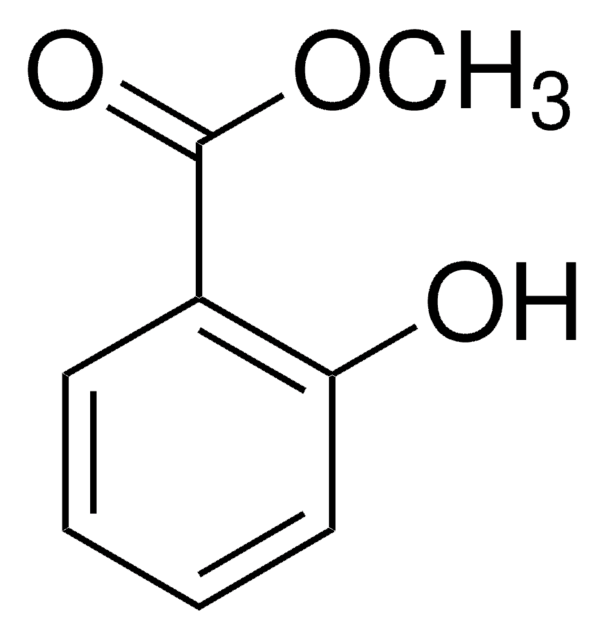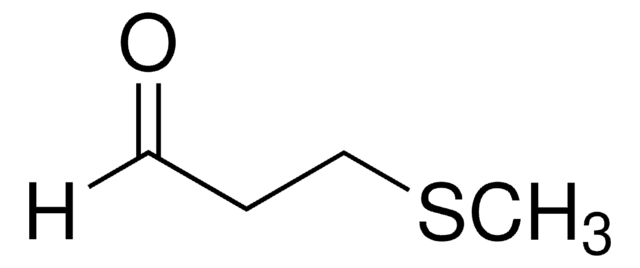W310204
Isovaleric acid
≥99%, FCC, FG
Sinónimos:
3-Methylbutanoic acid, 3-Methylbutyric acid
About This Item
Productos recomendados
origen biológico
synthetic
Nivel de calidad
grado
FG
Halal
Agency
meets purity specifications of JECFA
cumplimiento norm.
EU Regulation 1334/2008 & 872/2012
FCC
FDA 21 CFR 172.515
presión de vapor
0.38 mmHg ( 20 °C)
Análisis
≥99%
temp. de autoignición
824 °F
índice de refracción
n20/D 1.403 (lit.)
bp
175-177 °C (lit.)
mp
−29 °C (lit.)
densidad
0.925 g/mL at 20 °C (lit.)
aplicaciones
flavors and fragrances
Documentación
see Safety & Documentation for available documents
alérgeno alimentario
no known allergens
Organoléptico
cheese; fatty; acidic; sour
cadena SMILES
CC(C)CC(O)=O
InChI
1S/C5H10O2/c1-4(2)3-5(6)7/h4H,3H2,1-2H3,(H,6,7)
Clave InChI
GWYFCOCPABKNJV-UHFFFAOYSA-N
¿Está buscando productos similares? Visita Guía de comparación de productos
Descripción general
Palabra de señalización
Danger
Frases de peligro
Consejos de prudencia
Clasificaciones de peligro
Eye Dam. 1 - Skin Corr. 1B
Código de clase de almacenamiento
8A - Combustible corrosive hazardous materials
Clase de riesgo para el agua (WGK)
WGK 1
Punto de inflamabilidad (°F)
176.0 °F - Pensky-Martens closed cup
Punto de inflamabilidad (°C)
80 °C - Pensky-Martens closed cup
Equipo de protección personal
Faceshields, Gloves, Goggles, type ABEK (EN14387) respirator filter
Elija entre una de las versiones más recientes:
¿Ya tiene este producto?
Encuentre la documentación para los productos que ha comprado recientemente en la Biblioteca de documentos.
Los clientes también vieron
Artículos
Separation of Propionic acid; Acetic acid; Heptanoic acid; Isobutyric acid; Valeric acid; Isocaproic acid; Butyric acid; Isovaleric acid
Separation of Methyl oleate; Caprylic acid; Heptanoic acid; Methyl decanoate; Methyl dodecanoate; Myristic acid; Methyl palmitate; Methyl palmitoleate; Methyl stearate; Methyl linoleate; Methyl linolenate; Acetic acid; Arachidic acid; Behenic acid; Propionic acid; Isobutyric acid; Valeric acid; Isovaleric acid; Isocaproic acid; Butyric acid
Protocolos
In this study, SPME was used for the analysis of free fatty acids in Parmesan cheese using a 65 μm Carbowax/divinylbenzene (DVB) SPME fiber. Headspace extraction of the cheese sample was conducted at 65 °C for 15 minutes and analyzed by GC with FID detection. SPME is ideal for analyzing the volatiles associated with solid food samples. The phase chemistry of the Nukol GC column provides excellent peak shape of acidic compounds.
Nuestro equipo de científicos tiene experiencia en todas las áreas de investigación: Ciencias de la vida, Ciencia de los materiales, Síntesis química, Cromatografía, Analítica y muchas otras.
Póngase en contacto con el Servicio técnico













